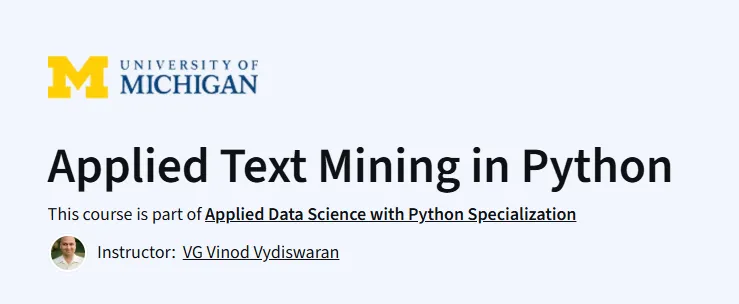What will you learn in Applied Text Mining in Python Course
- Clean and preprocess raw text using regular expressions and normalization techniques.
- Understand how text is represented and manipulated in Python, including encoding and tokenization.
- Leverage the NLTK framework for common natural language processing tasks such as part-of-speech tagging and feature extraction.
- Build supervised text classification pipelines to categorize documents and perform sentiment analysis.
- Implement topic modeling methods to discover themes and group similar documents.
Program Overview
Module 1: Working with Text in Python
⌛ 1 week
- Topics: Reading text files, interpreting UTF-8 encoding, tokenization into words and sentences, addressing common issues in unstructured text, writing regular expressions for pattern matching.
- Hands-on: Clean sample text files, extract dates and patterns using regex.
Module 2: Basic Natural Language Processing
⌛ 1 week
- Topics: Introduction to NLTK toolkit, tokenization, stemming, lemmatization, part-of-speech tagging, stop-word removal, feature derivation from text.
- Hands-on: Process raw text through NLTK, tag language constructs, and derive meaningful features for analysis.
Module 3: Text Classification and Supervised Learning
⌛ 1 week
- Topics: Converting text to numerical representations, training and evaluating classifiers (e.g., Naive Bayes), handling imbalanced datasets.
- Hands-on: Build and test a document classification model to automatically categorize news articles.
Module 4: Topic Modeling and Document Similarity
⌛ 1 week
- Topics: Probabilistic topic models (LDA), vector space representations, cosine similarity, clustering documents by theme.
- Hands-on: Apply LDA to discover latent topics in a corpus and group documents based on similarity metrics.
Get certificate
Job Outlook
- Roles like NLP Engineer, Data Scientist, and Text Analytics Specialist often require strong text preprocessing and modeling expertise.
- Demand for professionals skilled in text mining and NLP is rapidly growing across sectors such as technology, finance, healthcare, and media.
- Opportunities span research labs, startups, and large enterprises focused on unstructured data analysis.
Specification: Applied Text Mining in Python Course
|
FAQs
- Basic Python and introductory machine learning knowledge recommended.
- Focuses on text preprocessing, classification, and topic modeling.
- Includes hands-on exercises using NLTK and Python libraries.
- Prepares learners for real-world NLP tasks and text analytics.
- Ideal for learners aiming for roles in data science or NLP.
- Covers tokenization, lemmatization, stemming, and stop-word removal.
- Teaches pattern extraction using regular expressions.
- Focuses on transforming raw text into structured, analyzable formats.
- Includes hands-on exercises with sample datasets.
- Prepares learners for building reliable text-based models.
- Covers converting text to numerical representations for machine learning.
- Teaches building classifiers like Naive Bayes for document categorization.
- Includes handling imbalanced datasets and model evaluation.
- Hands-on practice with news articles or similar corpora.
- Enhances employability for NLP Engineer, Text Analytics Specialist, or Data Scientist roles.
- 4 modules, approximately 1 week each.
- Self-paced learning allows flexible scheduling.
- Modules cover text handling, NLP basics, classification, and topic modeling.
- Includes exercises for preprocessing, feature extraction, and modeling.
- Suitable for learners seeking intensive, applied NLP experience.
- Teaches Latent Dirichlet Allocation (LDA) for topic modeling.
- Covers vector space representation and cosine similarity metrics.
- Hands-on exercises to cluster documents by theme.
- Prepares learners for analyzing large text corpora efficiently.
- Skills transferable to professional NLP, research, or analytics projects.





